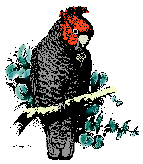I've always known these displays by Wedge-tailed Eagles as 'pot-hooking', and
used to mark a territory boundary: "flying up to almost vertical, stalling,
accelerating down, and repeating" as Peter notes. Other eagles nearby could be
the other bird of a pair, or equally could be the eagle in the adjacent
territory.
Steve
-----Original Message-----
From: Canberrabirds <> On
Behalf Of Philip Veerman via Canberrabirds
Sent: Sunday, 2 March 2025 10:50 PM
To: 'NF' <>; 'Peter Miller'
<>; 'CanberraBirds email list'
<>
Subject: Re: [Canberrabirds] wedgie flight patterns
Peter,
This is a fairly "common" thing to see. Pairs will fly together and one will do
these deep dives and then rise up to the same altitude. Sort of like following
a sine curve. I'm not sure "common" is exactly the right word but I have seen
it several times from the pair that I usually see over the Bullen range above
the Murrumbidgee river along the Kambah Pool track. I have seen it in a range
of other situations as well. It is presumably just a pair bonding display. Page
171 - 172 of HANZAB volume 2 provides a diagram and description of this
behaviour. I suspect most eagle species would also do something similar (but
that is an assumption).
I have never heard of Immelmann manoeuvre and looked it up. Found this (copied
below). I think it is a strange comparison and not based on birds, at least
according to this internet reference. I only knew the name Immelmann as the
author of the nice book on Australian finches (Klaus Immelmann).
The Immelmann maneuver (strange spelling! But that is google) is an aerial
maneuver that involves a half-loop followed by a half-roll. It's used to
quickly change the direction of flight.
History
The Immelmann maneuver is named after German World War I pilot Max Immelmann.
Immelmann used the maneuver to reposition his aircraft for another attack after
attacking another aircraft.
The maneuver was initially performed using Fokker Eindekkers, monoplane fighter
aircraft.
How it's performed Dive past the enemy aircraft, Pull sharply up into a
vertical climb, Turn hard to the side and down, and Dive a second time.
Challenges
The maneuver is difficult to perform and can be easy to fall out of.
It's especially difficult to perform in underpowered aircraft.
The maneuver makes the plane vulnerable to attack because of its slow hovering
speed.
Uses
The Immelmann maneuver is useful for regaining altitude quickly.
It's also a great maneuver to put right before a spin.
Philip
-----Original Message-----
From: Canberrabirds
On Behalf Of NF via Canberrabirds
Sent: Sunday, 2 March, 2025 9:43 PM
To: Peter Miller
Cc:
Subject: Re: [Canberrabirds] wedgie flight patterns
peter
yes numerous times i have seen wedgetails perform an immelmann manoeuvre and in
groups.
and little eagles. the scissors. like air combat.
and brown falcons.
it seems to me these are family members or breeding couples.
Nik
> On 2 Mar 2025, at 9:12 pm, Peter Miller via Canberrabirds
> <> wrote:
>
> I went for a walk with my son and a friend up to Old Joe, on the border
> between ACT/NSW at the NE corner of Goorooyaroo.
>
> Birds were not particularly plentiful (this was Friday morning), but we did
> have one really interesting observation.
>
> A wedgetail flew above us while we were at the top of Old Joe. But rather
> than riding the wind currents, he/she did a series of 6 or 7
> "scallops"-flying up to almost vertical, stalling, accelerating down, and
> repeating-all with nary a flap although the bird was clearly altering her
> wing shape. It just did the once, over maybe 400 or 500 metres and
> afterwards reverted to a much more normal soaring/circling pattern.
>
> Has anyone else observed this pattern in eagles or other raptors?
>
> I can't think of seeing anything like it-the closest I can come up with was
> watching white-necked ravens on an African mountain top which were doing
> somersaults in the wind-which at the time I thought of as play.
>
> thoughts?
>
> Cheers,
>
> Peter
>
> --
> This is the email announcement and discussion list of the Canberra
> Ornithologists Group.
> Emails posted to the list that exceed 2 MB (2,000 kB) in size, including
> attachments, will be rejected.
> All emails distributed via the list are archived at
> http://bioacoustics.cse.unsw.edu.au/archives/html/canberrabirds. It is a
> condition of list membership that you agree to your contributions being
> archived.
>
> Canberrabirds mailing list
>
> https://lists.canberrabirds.org.au/mailman/listinfo/canberrabirds
--
This is the email announcement and discussion list of the Canberra
Ornithologists Group.
Emails posted to the list that exceed 2 MB (2,000 kB) in size, including
attachments, will be rejected.
All emails distributed via the list are archived at
http://bioacoustics.cse.unsw.edu.au/archives/html/canberrabirds. It is a
condition of list membership that you agree to your contributions being
archived.
Canberrabirds mailing list
https://lists.canberrabirds.org.au/mailman/listinfo/canberrabirds
--
This is the email announcement and discussion list of the Canberra
Ornithologists Group.
Emails posted to the list that exceed 2 MB (2,000 kB) in size, including
attachments, will be rejected.
All emails distributed via the list are archived at
http://bioacoustics.cse.unsw.edu.au/archives/html/canberrabirds. It is a
condition of list membership that you agree to your contributions being
archived.
Canberrabirds mailing list
https://lists.canberrabirds.org.au/mailman/listinfo/canberrabirds
--
This is the email announcement and discussion list of the Canberra
Ornithologists Group.
Emails posted to the list that exceed 2 MB (2,000 kB) in size, including
attachments, will be rejected.
All emails distributed via the list are archived at
http://bioacoustics.cse.unsw.edu.au/archives/html/canberrabirds. It is a
condition of list membership that you agree to your contributions being
archived.
Canberrabirds mailing list
https://lists.canberrabirds.org.au/mailman/listinfo/canberrabirds
|

